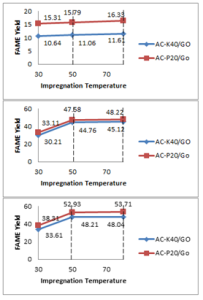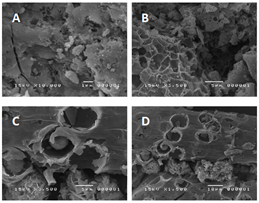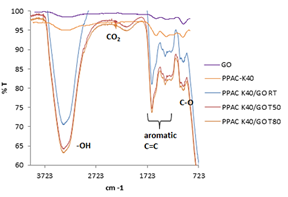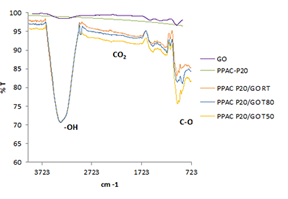Potential Heterogenous Catalyst from Pineapple waste for Biodiesel Production
- Angelika Uy
- Juliet Dalagan
- 629-638
- Jul 22, 2024
- Chemistry
Potential Heterogenous Catalyst from Pineapple waste for Biodiesel Production
Angelika Uy1, Juliet Dalagan*2, PhD
1Philippine Sinter Corporation, Villanueva, Misamis Oriental, Philippines, 9002
2Chemistry department, Xavier University, Cagayan de Oro, Philippines, 9000
*Corresponding Author
DOI: https://doi.org/10.51244/IJRSI.2024.1106048
Received: 08 June 2024; Revised: 17 June 2024; Accepted: 22 June 2024; Published: 22 July 2024
ABSTRACT
Biodiesel is a viable alternative to petroleum-based fuels due to its potential to lower greenhouse gas emissions. Recently, the utilization of waste biomass materials for the production of fuels and other energy products has been explored. In this current study, a potential heterogeneous solid catalyst was obtained from pineapple waste peels and graphite oxide (GO). Its potential for transesterification in biodiesel production was investigated using the impregnation mass ratio of 1 GO: 3 pineapple waste. The methanol to coconut oil molar ratio of 18:1, impregnation temperature of 80 °C and H3PO4 activating agent were found to yield the highest fatty acid methyl ester (FAME) yield of 53.71%.
Keywords: Biodiesel, Transesterification, Heterogeneous Catalyst, Pineapple waste peels, optimization, Graphite Oxide.
INTRODUCTION
As countries develop and living standards improve, the world consumption and demand for energy will also inevitably and rapidly increase. The largest source of world energy consumption remains to be petroleum. In January 2017, petroleum consumption in the Philippines was reported by the Department of Energy to be 391.85 thousand barrels per day [1]. This continuous increase in consumption brought out environmental concerns as petroleum-based diesel fuel is considered as one of the prime contributors in the global warming. Increase in the emission of greenhouse gases into the atmosphere was due to the combustion of fossil fuel. It has been shown that 98% of carbon emissions are from fossil fuel combustion. In the Philippines, CO2 emission was at level of 55 million metric tons in 2015, a change of 14.58 % from 48 million metric tons the previous year as shown in the Climate Transparency Report [2, 3].
Among the most promising fossil fuel alternatives, biodiesel is found to be effective because of its potential to reduce green house gas emissions. Biodiesel is proven to reduce overall CO2emissions by 78% as opposed to petroleum-based diesel fuel [4]. Biodiesel represents a renewable and eco-friendly biofuel suitable for use in diesel engines either in its pure form or when blended with traditional diesel. It is derived from oil conversion through methods like pyrolysis, micro-emulsification, and most notably, transesterification. Transesterification is the leading process for producing biodiesel that is both cleaner and more environmentally friendly. Additionally, it is known for delivering the highest bioenergy output in a shorter timeframe compared to other conversion processes [5].
Catalysts synthesized from biomass are under intensive investigation as possible alternatives to traditional chemical catalysts for the sustainable production of biodiesel. This interest is due to their excellent characteristics: high catalytic activity, low cost, abundant availability, and eco-friendly and efficient manufacturing processes. [6]. Heterogeneous catalysts for biodiesel production from agricultural wastes have been developed in recent years because they are cost-effective, chemically safe and easily accessible [7]. Reported studies on the use of fruit peel wastes to derive heterogeneous catalyst with excellent catalytic activities include banana [8-9], tamarind [10], passion fruit [11,12], avocado [13], citrus [14], etc.
The purpose of this study is to prepare a heterogenous catalyst from the fruit peel of Ananas comosus commonly known as pineapple which is commercially cultured in the Philippines and other tropical countries. Previous studies indicated that A. comosus contains high carbon content which means that it is a good source of activated carbon [15]. Another study done on A. comosus was the utilization of its leaves ash as a catalyst for biodiesel production [16]. However, little research has previously been conducted on the utilization of a composite material (fruit peel activated carbon in combination with graphite oxide) as catalyst in biodiesel production. The structure and properties of graphite oxide vary based on the synthesis method and the extent of oxidation. While it generally retains the layered structure of the original graphite, its layers become buckled, and the interlayer spacing increases to roughly twice that of graphite, approximately 0.7 nm. [17]. However, the graphite oxide must be further modified through impregnation to increase its functionalization. The impregnation with graphite oxide is said to enhance the durability of the produced complex catalyst. Impregnation is a process to fill the pore of a carrier with an active phase. It is a commonly employed process for supported catalysts in which it includes filling the pores of the support with the catalyst precursor solution. This is to achieve the desired loading and to enhance the efficiency of a catalyst. According to Julkapli et al., graphene tends to stack together via pi-to-pi interactions and enfoldment of graphene sheets and its small interlamellar spacing resulting to limiting its utilization. Thus, structural changes brought by impregnation with another chemical compound can be useful for extending the functionalization of graphene [18]. Hence this study was conducted to investigate its efficacy as well as to determine the optimized condition of certain specific reaction parameters.
EXPERIMENTAL
Materials
Pineapple peels were purchased outside the Bugo Cannery of Del Monte Philippines, Inc. Coconut oil was purchased from the local supermarket. HPLC-grade methanol (>99% purity, Scharlau) was procured from Merteflor. Graphite oxide was provided by Dr. Juliet Q Dalagan and Ms. Romelisa A Ibale. Other chemicals such as phosphoric acid and potassium hydroxide were supplied by the laboratory of Xavier University-Chemistry Department.
Approximately ten (10) grams of pineapple peel were immersed in 40 wt% KOH followed by heating in an oven for one hour until temperature was 80 ͦ C. The same procedure was done using 20 wt% H3PO4 as the activating agent. The dried pineapple peel was heated for 4 hrs in a furnace until the temperature of 400 ͦ C and 800°C for KOH and H3PO4 was achieved, respectively. The activated carbon was washed, dried 24 hours at 100 ͦ C and stored in a desiccator. Impregnation method was done to support pineapple peel activated carbon (PPAC) with graphite oxide in a mass ratio of 1:3 by combining 1.5 mg of GO to 4.5 mg PPAC in 3 mL of water. Stirring for 4 hours at room temperature, at 50°C and at 80°C was employed followed by drying in an oven for 12 h at 100 ͦC.
The catalyst produced was characterized using FTIR (Perkin Elmer FT-IR 100 Spectrometer) from the scanning range of 4000–400 cm-1 and Scanning Electron Microscopy (JEOL JSM 5310 SEM). Using transesterification reaction, coconut oil was converted to FAME with varying methanol to oil molar ratio of 6:1, 12:1 and 18:1 and fixed catalyst loading of 1.5%, reaction temperature of 60°C and rection time of 90 min. Vacuum filtration was used to isolate fatty acid methyl ester (FAME) followed by centrifugation. FAME composition was analyzed using Gas Chromatography with Flame Ionization Detection (HP-6890) with ultra-alloy as column and helium as the carrier gas.
RESULTS AND DISCUSSION
Carbonization and Chemical Activation
To produce activated carbon from pineapple peel wastes, phosphoric acid (H3PO4) and potassium hydroxide (KOH) were used as activating agents. The preparation included carbonization and activation using muffle furnace at 800°C for H3PO4-treated raw pineapple peels and 400°C for potassium hydroxide. Chemical treatment caused changes in color from yellowish green to brown/black and changes in texture from stiff to tender. PPAC by phosphoric acid (H3PO4) have relatively higher yield (27.76% ± 2.50) than KOH-activated PPAC (8.02% ± 2.34). In the work of Basta et al., lower carbon yield using KOH could be attributed to the breakdown of biomass into volatile matters [19].
The surface morphology of the raw pineapple peel and the prepared activated carbon were examined using SEM. The SEM images in Figure 1 showed a significant difference in the surface morphology of the raw sample without activation and the samples after activation with KOH and H3PO4. Non-porous and rugged surface was observed for the raw pineapple peels (Figure 1A). In contrast, uneven cavities and fine open pores were seen on the surface of the AC obtained after the chemical treatment (Figures 1B and 1C). The formation of these cavities could be due to the release of volatiles from the raw-PP during carbonization [20].
Fig. 1. SEM images of raw-PP (a), PPAC-KOHT400°C (b) and PPAC-H3PO4 T800°C (c) in 2,000x magnification
As for the SEM image of PPAC-H3PO4 T800°C in Figure 1C, surface morphology was irregular like that of PPAC-KOH T400°C but a clearer surface was observed. Ilomuanya et al. pointed out that phosphoric acid may be the reason for the unclogging of the micropores and mesopores by preventing the formation of tar [21]. The liberation of tar makes the surface more defined and finer. The porous structure illustrated in the SEM supports the possibility of AC as a catalyst modifier in which the pores could act as sites for adsorption.
Surface Functional Group Analysis
An overlay of the FTIR spectra is shown in Figure 2 which verified the presence of the functional groups in the raw PP and prepared AC. In raw PP, the presence of –OH stretching vibration at 3300-3400 cm-1 are indicators of the presence of alcohol, phenol, and carboxylic acid. The weak band at 2960-3000 cm-1 represents a C-H stretching-vibration while the weaker bands at 1260-1601 cm-1 can be attributed to C=C aromatic ring stretching vibration. The strong peak at 1031 cm-1 can be due to C-O. A very low signal for C=O was observed at 1746 cm-1 which probably means an inadequacy in the number of esters, ketones, and aliphatic acids in the raw pineapple peels. The spectra for PPAC-KOHT400°C and PPAC-H3PO4 T800°C showed same characteristic peaks. The prepared activated carbons demonstrate very weak absorbance for C-H stretching at 2993 cm-1 and 3000 cm-1. The reduced intensity of bands between 1260-1601 cm-1 may indicate the bond cleavage of C=C stretch and the progressive elimination of hydrogen functional groups. PPAC-KOHT400°C and PPAC-H3PO4 T800°C have lower intensity of C-O compared to raw-PP and both have no signal for C=O. The addition of activators at high temperature may have caused the degradation of organic material that weakened the surface structure of activated carbon and disappearance of some of the surface functional groups. Peaks slightly shifted towards higher wavenumber which can be linked to physical changes in the molecule. In FTIR spectra, shifting of peaks towards lower or higher wavenumber is related to mass of the molecule, with shifts to higher wavenumber corresponding to reduction in mass and vice versa. The changes may be due to internal or external effects of chemical activation on the molecule.
Fig. 2. Overlay FT-IR spectra of raw-PP, PPAC-K40 and PPAC-P20
Production of Graphite Oxide Catalyst (GO/AC)
GO has the tendency to stack together due to pi-to-pi interactions and enfoldment of graphite sheets. Its small interlamellar spacing prevents its utilization. Thus, structural defects from incorporating activated carbon can be useful for extending the functionalization of graphite [22].
Variation of impregnation temperature
Previous work of Sun et al. made use of Graphite Oxide (GO) with P-Phenylene Diamine (PPD) at temperature above and below room temperature (10 – 90°C) to produce the desired modified composites. Results showed structural changes as seen on its XRD patterns with interlamellar spacing d values increasing as reaction temperature increased [23]. Thus, in this study, heat treatment was tested in the impregnation of AC and GO. The effect of applying heat during impregnation was assessed based on its FAME yield. For all reaction conditions, an increase in impregnation temperature was directly proportional to the product yield. It can be inferred from the results that at elevated temperature, efficacy of the impregnated GO as catalyst was enhanced. The composites obtained at different temperatures were denoted as, AC/GO-T (T =30, 50 and 90) in Figure 3, where T represents the temperature.
Fig. 3. FAME yield at different impregnation temperature for 1:6 (Top), 1:12 (Middle) and 1:18 (Bottom) oil to methanol molar ratio
Surface Morphology Analysis
SEM was used to investigate the impregnation of graphite oxide. A closer look of graphite oxide, as shown in its SEM micrograph in Figure 4A, shows a rough surface with debris that can be attributed to its oxygen functionalities [24]. PPAC/GO composites, at impregnation temperature of 80 °C, then showed a combination of porous structure and flat surfaces which can be an indication that PPAC and GO interacted [25]. The SEM images of PPAC-H3PO4/GO composites indicate the surface modification of GO after functionalization at different temperatures, as shown in Figure 5. At impregnation of RT, the surface contained several pits. This may mean partial adsorption of GO to the pores of AC but considering the nature of the material, it could be interpreted in another way. A fully anhydrous GO is very hard to achieve since GO consists of many ‘micro/nano’ pockets that can trap both H2O and CO2. Here, CO2 may have freely chemisorbed onto the GO scaffold via G-OH to G-O-C(=O)-O-G causing interaction between CO2 and H2O. This phenomenon cannot be observed in AC since it has already undergone heating at extreme temperatures. However, the H2O from GO may have reacted with the oxygen functionalities present in AC thereby stunting the progress in the impregnation of GO to AC. The temperature is most likely a key factor in the incomplete interaction of AC and GO as was also resulted in the study of Sharma et al. [26]. In PPAC-H3PO4/GOT50°C, disorder in the composite surface is clearly apparent in its SEM image. This was probably due to the higher interaction between AC and GO, which caused GO molecules to react with the oxygen-containing groups in AC through polymerization [27]. Compared to PPAC-H3PO4/GOT80°C, the GO surface appeared flatter and smoother which could mean complete impregnation of GO to AC.
Fig. 4. SEM micrographs of GO (a), PPAC-KOH/GOT80°C (b) and PPAC-H3PO4/GOT80°C (c and d) at 10,000x, 3,500x, 3,500x and 1,500x, respectively
Fig. 5. SEM micrographs of PPAC-H3PO4/GO at RT (a), T50, (b) and T80 (c) at 2,000x magnification.
Surface Functional Group Analysis
The impregnation of AC/GO can be supported by the FT-IR peaks shown in Figures 6 and 7. The absence of absorption peaks caused by carboxyl group (O-C=O) and epoxy group (C-O-C) is an indication that only non-covalent hydrogen and very few ionic bonds occurred in the impregnation [28]. In both acid and base treated AC/GO composites, the O- H bond is most likely strengthened by a stronger interaction in non-covalent hydrogen bonding as seen in shifting of the band to a higher wavenumber. Unimpregnated GO and AC have a very low peak intensity when overlaid with AC/GO composites. The increase in peak intensity after impregnation could mean that the GO was indeed impregnated.
Fig. 6. Overlay FT-IR Spectra of KOH-treated AC/GO composites
Fig. 7. Overlay FT-IR Spectra of H3PO4-treated AC/GO composites
Utilization of GO/AC in the Transesterification of Coconut Oil
The potential of GO-AC catalysts was investigated via transesterification reaction using different coconut oil to methanol molar ratio (1:6, 1:12 and 1:18). The reaction time, temperature and catalyst loading were held constant at 1.5 hours, 65ºC, and 1.5 (w/w)%, respectively. A trend was observed in relation to the amount of methanol used to the FAME yield. As the oil to methanol molar ratio increases, FAME yield also increases. As shown in Table 1, a notable difference was observed between 1:6 and 1:12 molar ratio with slight deviation between 1:12 and 1:18 molar ratio. The % yield of Fatty acid methyl ester (FAME) of various transesterification reactions were investigated based on GC analysis. The 1:18 oil to methanol molar ratio exhibits the highest yield of FAME with an average value of 53.58 % ± 0.14. Another thing that can be observed is that the base-treated AC/GO composites exhibit lower catalytic activity than acid-treated AC/GO composites [29]. The extension of functionalization of GO is indeed affected by the species involved in the impregnation as shown in Figure 8. Thus, the expected extension of functionalization of GO was achieved because of the successful interaction of PPAC and GO during impregnation.
Table 1. FAME Yield of prepared catalysts at different coconut oil to methanol molar ratio
| Catalyst | FAME Yield | |||
| At 1:6 oil to methanol ratio | At 1:12 oil to methanol ratio | At 1:18 oil to methanol ratio | ||
| A | Without catalyst | 0.85 | 1.17 | 1.23 |
| B | PPAC-KOH T400°C | 10.93 | 12.31 | 12.72 |
| C | PPAC-H3PO4 T800°C | 15.68 | 23.16 | 28.63 |
| D | PPAC-KOH/GORT | 10.64 | 30.21 | 33.61 |
| E | PPAC-H3PO4/GORT | 15.31 | 33.11 | 38.31 |
| F | PPAC-KOH/GOT50°C | 11.06 | 44.76 | 48.21 |
| G | PPAC-H3PO4/GOT50°C | 15.79 | 47.58 | 52.93 |
| H | PPAC-KOH/GOT80°C | 11.61 | 45.12 | 48.04 |
| I | PPAC-H3PO4/GOT80°C | 16.33 | 48.22 | 53.71 |
Fig. 8. Comparison of FAME Yield values at optimum oil to methanol ratio
CONCLUSIONS
The structural changes brought about by the impregnation of activated carbon from pineapple peel (PPAC) with graphite oxide (GO) were useful for extending the utilization and functionalization of graphite oxide as catalyst. The following conditions were found to be optimum to produce biodiesel: 1:18 oil to methanol molar ratio, 1.5% catalyst loading, 60˚C reaction temperature, and 90 min reaction time. PPAC-H3PO4/GOT80°C gave the highest yield of 53.71%.
DECLARATIONS
Conflict of interest On behalf of all authors, the corresponding author states that there is no conflict of interest.
Ethics approval This article does not contain any studies with human participants or animals performed by any of the authors.
Consent to participate Informed consent is not applicable.
Informed consent Informed consent is not applicable.
REFERENCES
- Climate Transparency (2021) https://www.climate-transparency.org/wp-content/uploads/2021/01/Philippines-CT-2020.pdf. Accessed on September 21, 2023.
- Department of Energy (2020) Energy Situationer – Total final energy consumption. https://www.doe.gov.ph/sites/default/files/pdf/announcements/1_Energy%20Situationer. Accessed on September 21, 2023.
- Schneider UA, Mccarl BA (2003) Economic Potential of Biomass-Based Fuels for Greenhouse Gas Emission Mitigation. Environ. Resour. Econ. 24:291–312. https://doi.org/10.1023/A:1023632309097
- Van Gerpen J (2005) Biodiesel Processing and Production. Fuel Process. Technol. 86:1097–1107.
- https://doi.org/10.1016/j.fuproc.2004.11.005
- Umeagukwu OE, Onukwuli DO, Ude CN, Chizoo E, Ekwueme BN, Asadu CO, Ugwele FO (2024). Techno-economic analysis of the statistically optimized biodiesel production process using African pear seed oil and activated empty palm fruit bunch biocatalyst. Waste Management Bulletin, 2(2), 95-112. https://doi.org/10.1016/j.wmb.2024.03.006
- Ao S, Changmai B, Vanlalveni C, Chhandama MVL, Wheatley AE, Rokhum SL (2024). Biomass waste-derived catalysts for biodiesel production: Recent advances and key challenges. Renewable Energy, 120031. https://doi.org/10.1016/j.renene.2024.120031
- Awogbemi O, Von Kallon DV, Aigbodion VS (2021). Trends in the development and utilization of agricultural wastes as heterogeneous catalyst for biodiesel production. Journal of the Energy Institute, 98, 244-258. https://doi.org/10.1016/j.joei.2021.06.017
- Odude VO, Adesina AJ, Oyetunde OO et al.(2019). Application of Agricultural Waste-Based Catalysts to Transesterification of Esterified Palm Kernel Oil into Biodiesel: A Case of Banana Fruit Peel Versus Cocoa Pod Husk. Waste Biomass Valor 10, 877–888. https://doi.org/10.1007/s12649-017-0152-2
- Daimary N, Boruah P, Eldiehy KS, Pegu T, Bardhan P, Bora U, Deka D (2022). Musa acuminata peel: A bioresource for bio-oil and by-product utilization as a sustainable source of renewable green catalyst for biodiesel production. Renewable Energy, 187, 450-462. https://doi.org/10.1016/j.renene.2022.01.054
- Nabora CS, Kingondu CK, Kivevele TT (2019). Tamarindus Indica fruit shell ash: a low cost and effective catalyst for biodiesel production from Parinari curatellifolia seeds oil. SN Appl. Sci. 1, 253. https://doi.org/10.1007/s42452-019-0256-3],
- Tarigan JB, Singh K, Sinuraya JS, Supeno M, Sembiring H, Tarigan K, Sitepu EK. (2022). Waste passion fruit peel as a heterogeneous catalyst for room-temperature biodiesel production. ACS omega, 7(9), 7885-7892. https://doi.org/10.1021/acsomega.1c06785
- Barros SDS, Nobre FX, Lobo WV, Duvoisin Jr, S, de Souza CA, Herminio VLDQ, de Freitas FA (2024). Eco‐friendly biodiesel production using passion fruit peels and cupuaçu seeds: Catalyst development and process optimization. Biofuels, Bioproducts and Biorefining, 18(1), 96-112. https://doi.org/10.1002/bbb.2551
- Rajendran N, Kang D, Han J, Gurunathan B (2022). Process optimization, economic and environmental analysis of biodiesel production from food waste using a citrus fruit peel biochar catalyst. Journal of Cleaner Production, 365, 132712. https://doi.org/10.1016/j.jclepro.2022.132712
- Etim AO, Musonge P (2024). Synthesis of a Highly Efficient Mesoporous Green Catalyst from Waste Avocado Peels for Biodiesel Production from Used Cooking–Baobab Hybrid Oil. Catalysts, 14(4), 261. https://doi.org/10.3390/catal14040261
- Foo KY, Hameed BH (2012) Porous Structure and Adsorptive Properties of Pineapple Peel Based Activated Carbons Prepared via Microwave Assisted KOH and K2CO3 activation. Microporous Mesoporous Mater. 148:191–195.
- https://doi.org/10.1016/j.micromeso.2011.08.005
- Barros SDS, Junior WAP, Sá,IS, Takeno ML, Nobre FX, Pinheiro W, de Freitas FA (2020). Pineapple (Ananás comosus) leaves ash as a solid base catalyst for biodiesel synthesis. Bioresource Technology, 312, 123569. https://doi.org/10.1016/j.biortech.2020.123569
- Punjabi PB, Ameta R, Gupta S (2023) Graphene-based Carbocatalysts: Synthesis, Properties and Applications, (eds). Bentham Science Publishers Pte. Ltd. Singapore. 2:91-93. DOI:2174/97898150508991230101
- Julkapli NM, Bagheri S (2015) Graphene Supported Heterogeneous Catalysts : An Overview. Int J Hydrogen Energy 40:948-979. https://doi.org/10.1016/j.ijhydene.2014.10.129
- 21. Basta AH, Fierro V, El-saied H, Celzard A (2009) 2-Steps KOH activation of rice straw: an efficient method for preparing high-performance activated carbons. Bioresour. Technol. 100: 3941–3947. doi: 10.1016/j.biortech.2009.02.028
- Lam SS, Liew RK, Wong YM, Azwar E, Jusoh A, WahiR (2017) Activated Carbon for Catalyst Support from Microwave Pyrolysis of Orange Peel. Waste Biomass Valor. 8:2109–2119. DOI: 1007/s12649-016-9804-x
- Ilomuanya MO, Nashiru B, Ifudu ND, Igwilo CI (2016) Effect of Pore Size and Morphology of Activated Charcoal Prepared from Midribs of Elaeis Guineensis on Adsorption of Poisons Using Metronidazole and Escherichia Coli. J. J Microsc Ultrastruct 5:32-38. DOI: 1016/j.jmau.2016.05.001
- Eigler S, Hirsch A (2014) Chemistry with Graphene and Graphene Oxide – Challenges for Synthetic Chemists. Angew. Chem. Int. Ed. 53:7720-7738. https://doi.org/10.1002/anie.201402780
- Sun H-J, Liu B, Peng T-J, Zhao X-L (2018) Temperature on Structure , Appearance and Bonding Type of Functionalized Graphite Oxide Modified P-Phenylene Diamine. Materials 11:647-659. https://doi.org/10.3390/ma11040647
- 26. Shen L, Zhang L, Wang K, Miao L, Lan Q, Jiang K, Lu H, Li M, Li Y, Shen B, Zheng W (2018) Analysis of oxidation degree of graphite oxide and chemical structure of corresponding reduced graphite oxide by selecting different-sized original graphite. RSC Adv. 8:17209-17217. https://doi.org/10.1039/C8RA01486H
- Papelleras H, Dalagan JQ (2021) Optimization Study on the Use of Graphene Oxide-Supported Activated Carbon as Catalyst for Biodiesel Production: An Initial Investigation. Int. J. Sci. Res. 10:491-495. DOI: 10.21275/SR211108110247
- 28. Sharma G, Sharma S, Kumar A, Lai CW, Naushad M, Shehnaz, Iqbal J, Stadler FJ (2022) Activated Carbon as Superadsorbent and Sustainable Material for Diverse Applicationss. Adsorp Sci Technol. 2022:1-21. https://doi.org/10.1155/2022/4184809
- Sun J, Liu X, Duan S, Alsaedi A, Zhang F, Hayat T, Li J (2018) The influential factors towards graphene oxides removal by activated carbons: Activated functional groups vs BET surface area. Journal of Molecular Liquids 271:142-150. DOI: 1016/j.molliq.2018.08.118
- 30. Chowdury MSK, Cho YJ, Park SB, Park Y (2023) Review—Functionalized Graphene Oxide Membranes as Electrolytes. J. Electrochem. Soc. 170:033503-033531. DOI 10.1149/1945-7111/acc35e
- Brito CHV, Gloria DCS, Santos EB, Domingues RA, Valente GT, Vieira NCS, Gonçalves M (2023) Porous activated carbon/graphene oxide composite for efficient adsorption of pharmaceutical contaminants. Chem Eng Res Des 191:387-400. DOI:1016/j.cherd.2023.01.044








